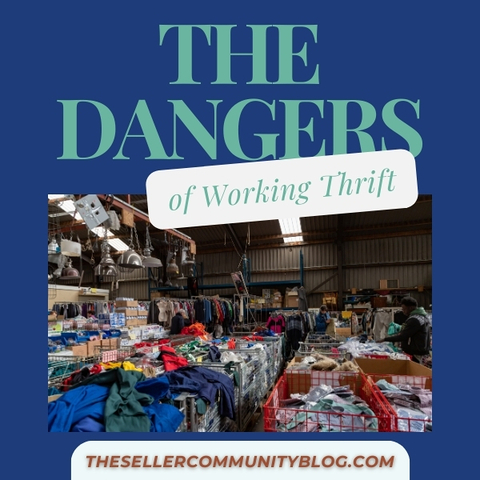Estimated reading time: 6 minutes
I want to delve into the scary side of working in a thrift store. It’s got all the home-field advantages of retail, like angry customers and mean managers, but it also has its own special hurdles. And needles. More needles than you might think, friend.

Erin’s story
One of my coworkers, Erin, a girl with a thousand stories by the way, was sorting through a bag and felt a prick on her forefinger. She pulled a hypodermic needle from the pocket of a pair of jeans and, weirdly, stayed in an almost eerie calm about it. Erin had worked in the store for years and explained that most needles are the remnant of some careless diabetic. She said that nine times out of ten when you find a needle, there’s usually a discarded vial of insulin with it. Although we didn’t find one in the same bag, she seemed unnerved and went home.
She didn’t show up the next day. Or the next. Turns out, Erin was in the hospital. When she woke up the morning after being injected, her hand had swollen so badly that when she tried to move her fingers, the skin cracked and bled. Her vision was blurry, and her fingers were turning black. She, somehow, made it to the emergency room with the help of her nine-year-old daughter who had to turn the wheel for sharper turns, and they threw her into surgery. They never found out what it was, but she made a complete recovery. That explained one day of absence.
The morning of the second day, Erin had woken up to a knock on the door from Child Protective Services. You see, Erin was a single mother and recovering addict on probation. She had told her doctors before surgery that she couldn’t have any opioids, but they assured her it would be ok.
Apparently, it was not ok.

As soon as the state found out she had more junk in her system, they said she violated her probation and came to take her daughter away. About a week later, some higher-ups relented and admitted that they acted rashly. They returned her daughter with an apology, and life resumed some sort of normality, but the emotional damage was done.
Erin hadn’t come to work the second day because she was so freaked out that she most likely forgot she had a job. I understood that. A woman in a suit had shown up on her doorstep with two cops and took her child away. I can’t imagine that kind of stress.
Our manager apparently hadn’t understood.
When she returned on the third day, she was told that both absences counted as “no call, no shows”, and that one more such absence would result in her immediate termination. Because she hadn’t kept the syringe, and because the doctors could not tell her technically what had caused her massive hand inflation, she also couldn’t claim worker’s comp for the injury.
Let me say it out loud for anyone who doesn’t know, it can cost a lot to work a low-paying job.
Erin had to decide if she wanted to pick up more shifts to pay for her hospital bills or spend more time with her daughter, who was traumatized from a week in foster care. Don’t get me wrong, foster care can be great and the parents who do it are amazing, but Erin’s daughter was terrified. The woman who had taken her from her home had told this little girl that her mom was a junkie who couldn’t take care of her. She was just left with a new family, wearing clothes that weren’t hers, and told not to contact her mother.
But what could Erin do? She worked the extra shifts.
The jumpers
I think we all need a little comic relief, so let me tell you about the jumpers.
Allow me, dear colleagues and friends, to explain that term more fully. Most thrift stores recycle their unsalable products through the same small handful of vendors, and those vendors tend to use the same tools. For clothing, that highly technological, patent-pending, groundbreaking tool is a nine to ten-foot-tall metal rectangle with a pallet on the bottom and four thick metal poles on each side. It gets the job done.
Basically, we wrap the box up in a kind of reinforced plastic wrap, wheel it inside, and fill it with clothes. When it is completely full, they take it away, disembowel it, and send it forth. Please note the use of the word completely…

We are paid by the pound for clothing, so one of those cages didn’t go out until it was full. FULL. Like, starving aspiring actresses at an all-you-can-eat buffet, full. And let me tell you, clothes compress. So, in direct violation of OSHA regulations and direct orders, we were routinely required to jump the cages.
A girl would climb on up, jump in when the cages were about four, six, eight and ten feet filled, and jump them down like they’re in a half-crazed pigeage. (Look it up, I had to.) This was a flagrant safety violation because, well, people got hurt.
Amanda once jumped the clothing down so successfully that she got trapped and had to be cut out. Erin had a dangly earring snag mid-jump and it ripped out of her ear. Another time, Amanda jumped too far on the outside, (always stay in the middle, people) and one of her legs slid through the plastic wrap. The weight of her body pulled her down and smushed her face against the plastic wrap like a kid against a car window. We cut her out again after we realized she could barely breathe, and after pictures were taken.
Possessions were routinely lost, either through the up and down of the jumping or simply taken by the quicksand-like mass of clothing below. Shoes numbered as the greatest casualties, though dignity often took a hit as well. The male employees gathered like a school of surgeonfish whenever we jumped. Pure coincidence, we were assured.
Strange illnesses
I’ll try to spare you the sordid details of the many strange illnesses we contracted in the store. Suffice it to say that some of my friends went home with lice, bed bugs, weird infections, and even scabies once. Wear gloves, you say, from your lofty peanut gallery? We tried. We were told that it was scaring customers and soon after, the boxes of gloves and masks mysteriously disappeared from the stockroom. Our manager claimed to know nothing.
Sorting clothing was not days spent neatly folding laundered items in perfect condition sans tags. No dear, we used to suit up like turn-of-the-century coal miners, gear and attitude set. I found underwear with skid marks, used bloody pads still attached, and, let’s just say, “used” lingerie on multiple occasions.




